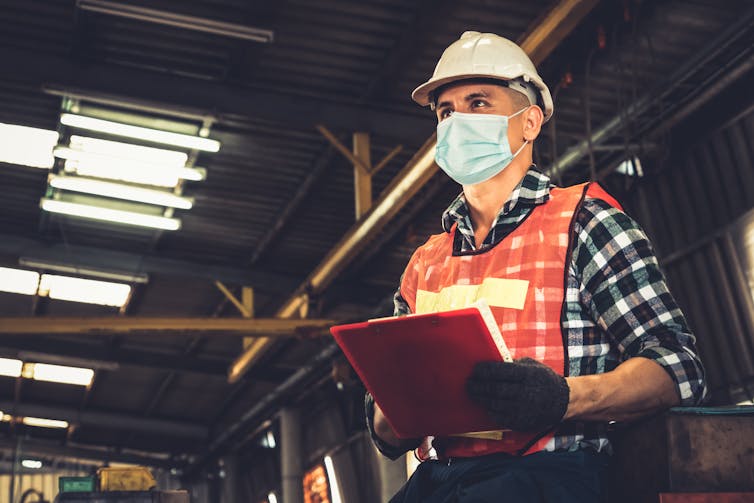August 4, 2020
PPE unmasked: why health-care workers in Australia are inadequately protected against coronavirus
The need for advanced-level PPE is becoming increasingly crucial to protect front line health care workers fighting COVID-19
In Victoria, health-care workers have now been infected with SARS-CoV-2, the coronavirus that causes COVID-19. Some 11% of active cases are workers in the health-care sector.
Health-care workers are reported to be among those in Victorian intensive care units.
While we donāt know what proportion of the Victorian health-care workers currently infected with COVID-19 acquired it at work rather than in the community, itās almost certain a portion of these infections were contracted in the workplace.
Early experience from China found the proportion of health-care workers who contract COVID-19 can be in settings with inadequate personal protective equipment, or PPE.
Lessons from China also show workplace transmission of SARS-CoV-2 can be with sufficient supply, and correct use of, airborne precaution PPE.
Right now, Australia is sitting somewhere in the middle. National guidance needs to be urgently updated to reflect safest practice and acknowledge what weāre learning about the airborne spread of the virus.
Read more:
What is PPE?
PPE is a of controlling exposure to hazards .
It includes items such as masks, respirators, face shields, gowns and gloves.
PPE is categorised into , corresponding to the type of hazard.
Level 1: standard and contact precaution PPE
This PPE limits exposure to standard contact hazards. Examples include face coverings and administrative controls such as hand hygiene, cough etiquette and physical distancing.
Level 2: droplet precaution PPE
This PPE prevents exposure to contact and droplet hazards. Examples include surgical masks, eye shields or goggles, long-sleeved gowns, and gloves.
Level 3: airborne precaution PPE
This PPE aims to prevent exposure to contact, droplet and airborne hazards. It N95/P2 respirators or powered air-purifying respirators , eye shields or goggles, fluid-resistant gowns, double gloves, disposable head and neck wear, and protective footwear.

Current Australian guidelines
The on the use of PPE in hospitals during the COVID-19 outbreak has been written by the Infection Control Expert Group and endorsed by the Australian Health Protection Principal Committee.
The guidance doesnāt recommend universal airborne precaution PPE for health-care workers dealing with patients suspected or confirmed to have COVID-19. It only recommends level 3 protection for highly specialised procedures such as intubating a patient.
Read more:
A preprint in the has criticised the current guidance, noting itās not aligned with increasing scientific evidence regarding airborne transmission of SARS-CoV-2 and is therefore inadequate to protect health-care workers.
Inadequate national guidance has led to an to airborne precaution PPE across all health-care settings.
In the absence of strong national safety guidance, some hospitals and jurisdictions are making to their staff.
Why we need level 3
Transmission of SARS-CoV-2 occurs by direct contact with droplets and contaminated surfaces ā but suggests it can also be spread by the airborne route.
An analysis of health-care worker deaths in the United Kingdom found , suggesting airborne precaution PPE was protective.

Importantly, surgical masks are primarily designed to protect the environment from the wearer. Theyāre to protect the wearer from respiratory pathogens.
A recent review found N95 respirators offered against viruses including COVID-19 than surgical face masks, while one study found N95 respirators provided more protection than surgical masks against small viral particles.
Read more:
In Australia, N95 is synonymous with P2 respiratory protection and refers to the filtration efficiency (so N95 means 95% of particles are filtered). But itās the total inward leakage ā what goes through and around the facemask ā thatās the critical factor in determining the level of protection the wearer achieves.
To ensure total inward leakage is minimised, respiratory masks used under level 3 PPE certain , including fit testing and the training of wearers in their use.
We need immediate action
SARS-CoV-2 is a with the potential to cause significant ill health and death. In health-care settings, it should be classified as a lethal and managed accordingly.
The safest approach is to consider all people with confirmed or suspected COVID-19 in hospital, being transported to hospital or being tested for COVID-19 as being able to spread the virus via the airborne route. As such, the use of airborne precaution PPE with a correctly fitted N95/P2 respirator is essential.
Read more:
Thereās also an urgent need for a national registry of health-care worker infections, containing data about the category of health-care worker, where the infection was acquired, severity of disease, hospitalisation, intensive care and death numbers.
This will give us a better understanding of the scope and specifics of the problem, and inform policy and prevention strategies.
Finally, adequate supply of airborne precaution PPE must be available throughout Australia to protect health-care workers from COVID-19.![]()
, Associate Professor MBBS, PhD, MPH, PGDipEcho, FANZCA, and , Certified Occupational Hygienist,
This article is republished from under a Creative Commons license. Read the .
UOW academics exercise academic freedom by providing expert commentary, opinion and analysis on a range of ongoing social issues and current affairs. This expert commentary reflects the views of those individual academics and does not necessarily reflect the views or policy positions of the ¾«¶«“«Ć½ of ¾«¶«“«Ć½.
:format(jpg)/prod01/channel_3/assets/media-centre/The-Conversation-PPE-Masks.jpg)